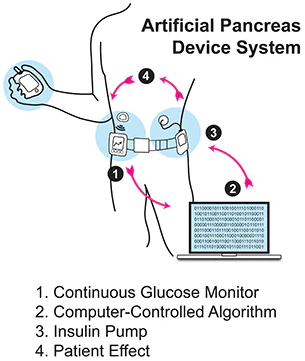
Last updated on May 23rd, 2024 at 05:06 pm
More than 37 million Americans have diabetes, which causes high blood sugar. Normally, your body produces insulin, a hormone that helps regulate levels of blood glucose, also called blood sugar. With diabetes, your body either can’t produce enough insulin or can’t properly use the insulin it does produce. For people with type 1 diabetes, the immune system destroys cells in the pancreas that make insulin. This causes sugar to build up in the blood. Over time, high blood sugar can damage your nerves, heart , eyes, kidneys, gums and teeth, and other organs.
While type 2 is the most common type of diabetes, 5% of people in the United States with diabetes have type 1. This disease is usually diagnosed in children and young adults, but it can appear at any age. Having a parent or sibling with this disease may increase your chance of developing it.
We don’t know for sure what causes type 1 diabetes, but experts think it may be caused by genes and environmental factors that might trigger the disease. Recent research shows we can also delay the onset of type 1 diabetes and even detect early stages, before clinical symptoms appear.
What are the symptoms?
Symptoms of type 1 diabetes are serious and usually start over a few days to weeks. They may include:
- Being very thirsty
- Peeing often
- Feeling very hungry or tired
- Losing weight without trying
- Having dry, itchy skin
- Losing feeling in your feet or feeling tingling in your feet
- Having blurry eyesight
Type 1 diabetes also affects blood flow around a wound, which can make it harder for your skin to heal from injuries. Chronic diabetic wounds that don’t heal within a few weeks or months may lead to limb amputations, disability, and even death.
Sometimes symptoms of type 1 diabetes are signs of a life-threatening condition called diabetic ketoacidosis (DKA). If you or your child have symptoms of DKA, contact your health care professional immediately or go to the nearest emergency room. These symptoms include:
- Breath that smells sweet or like fruit
- Dry or flushed skin
- Nausea or vomiting
- Stomach pain
- Trouble breathing
- Trouble paying attention or feeling confused

People with type 1 diabetes need to check their blood sugar daily to make decisions about food, physical activity, and medicines.
How is it diagnosed?
A blood test can show whether you have diabetes. But these tests cannot tell the type of diabetes you have. To tell if your diabetes is type 1, your health care provider may test your blood for certain autoantibodies. Autoantibodies attack your healthy tissues and cells by mistake. Because type 1 diabetes can run in families, your health care provider may also want to test your family members for autoantibodies.
How is it treated?
People with type 1 diabetes must take insulin every day. There are multiple types of insulin, and each works for different lengths of time. Your health care provider can determine what type of insulin you need and whether you need to use more than one type.
You can take insulin in different ways, including injections or an insulin pump. Injections are needed several times during the day, while a pump gives you small, steady doses throughout the day.
People with type 1 diabetes also need to check their blood sugar daily to make decisions about food, physical activity, and medicines. Research shows that people with type 1 diabetes may benefit from a continuous glucose monitor—a device that automatically checks blood sugar levels throughout the day and night—or an artificial pancreas. An artificial pancreas combines a continuous glucose monitor, an insulin pump, and a software program to automatically check your blood sugar levels. It also delivers insulin to your body when you need it.

The continuous glucose monitor sends information through a software program called a “control algorithm.” The control algorithm could be installed on a computer, cell phone, or other device. The algorithm tells the insulin pump how much insulin to deliver.
For people ages 8 and older with autoantibodies and an early stage of type 1 diabetes, an injectable medication called teplizumab may slow the progress of the disease.
No matter what treatments you use to manage type 1 diabetes, it’s important to eat a healthy diet, avoid smoking, and get regular physical activity. Some people also follow a special meal plan to manage their blood sugar.
Talk with your health care provider about creating a treatment plan that works for you. Don’t change it without first talking to your provider. Also, talk to them about whether diabetes medicines will give you side effects or interact with other medicines you take.
By following a treatment plan and making positive lifestyle changes, people with type 1 diabetes can lead full, healthy lives.
